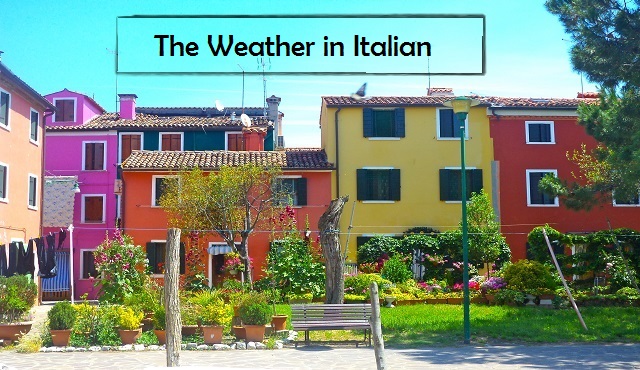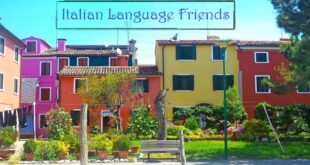For a general assessment of the weather, Italians use the multipurpose verb fare (‘to do’ or ‘to make’) in the third person singular, which you’ll remember is fa.
In English, the verb ‘to be’ is used to refer to what the weather actually is outside. Instead, Italians speak of what the weather is doing or making. It’s very important to think in Italian if we want to talk about the weather in Italian.
Remember that the reference to “it” in the Italian sentence will be left out, as usual.
Below are some examples of how this works, with the correct English translation in black and the literal Italian translation in gray, so we can understand the Italian language approach to this topic.
If you want to ask someone how the weather is, rather than telling them, you can use many of the same phrases, but just raise your voice at the end of the sentence. There is no need to invert the subject and the verb, as we do in English.
Notice that in Italian the same word means both time and weather — il tempo.
Che tempo fa?
What is the weather? (lit. What weather does it make?)
| Fa caldo. Fa molto caldo! Fa caldo? |
It is warm/hot. It is very hot! Is it warm/hot? |
(lit. It makes heat.) |
| Fa fresco. Fa fresco? |
It is cool. Is it cool? |
(lit. It makes cool.) |
| Fa freddo. Fa freddissimo! Fa freddo? |
It is cold. It is very cold! Is it cold? |
(lit. It makes cold.) |
| Fa bel tempo. Fa bel tempo? |
It is nice weather. Is it nice weather? |
(lit. It makes nice weather.) |
| Fa bello.
Fa bellissimo. |
It is nice/very nice out. | (lit. It makes nice/very nice weather.) |
| Fa brutto tempo. Fa brutto tempo? |
It is bad weather. Is it bad weather? |
(lit. It makes bad weather.) |
| Fa brutto. | It is bad outside. | (lit. It makes bad weather.) |
Of course, we may want to know how the weather was during a certain event or at a certain time. Chatting about the weather is a common pastime in any country. Why not chat about how the weather was in Italian?
To talk about the weather in the immediate past tense, we must return to the imperfetto and the passato prossimo. We have been learning about these two forms of the past tense recently, in our last two blogs in this series. For a more in-depth explanation of how to use the imperfetto and passato prossimo forms of the Italian past tense, click on the link for the verb tense you want to learn about.
The imperfetto third person singular form of fare, which is faceva, is the most commonly used form with our general expressions.
Of course, if we want to refer to a specific time frame, the passato prossimo third person singular form of fare, which is ha fatto, should be used.
Below are general questions about the weather, this time in the past tense:
| Che tempo faceva? | What was the weather? | (lit. What weather did it make?) |
| Come era il tempo? | How was the weather? |
And our answers, depending on the situation…
| Faceva caldo. | It was hot. | (lit. It made heat.) |
| Ha fatto caldo tutto il giorno. | It was hot all day. | |
| Faceva fresco. | It was cool. | (lit. It made cool.) |
| Ha fatto fresco ieri. | It was cool yesterday. | |
| Faceva freddo. | It was cold. | (lit. It made cold.) |
| Ha fatto freddo quest’inverno. | It was cold all winter. |
| Faceva bel tempo. | It was nice weather. | (lit. It made nice weather.) |
| Faceva bello. | It was nice outside. | (lit. It made nice weather.) |
| Faceva brutto tempo. | It was bad weather. | (lit. It made bad weather.) |
| Faceva brutto tempo. | It was bad outside. | (lit. It made bad weather.) |
Now, let’s try to be more specific and descriptive when we talk about the weather in Italian; let’s talk about common weather conditions, such as the rain, snow and wind, and how the weather changes throughout the seasons.
Below are a few conversational sentences. Since I am living in the Chicago area, I couldn’t resist a few lines about the show we’ve had to shovel this past winter (although this does seem a long time ago by now). How many more can you think of?
| È primavera.* | It is springtime. |
| Ci sono nuvole scure. | There are dark clouds. |
| Viene a piovere. | It is going to rain. (lit. Here comes the rain.) |
| C’e la pioggia? | Is it raining? |
| Piove. | It’s raining. |
| Tira vento. | It’s windy. |
| I fiori sono in fiore. | The flowers are blooming. |
| Ho un mazzo di rose rosse che ho colto dal giardino. | I have a bunch of red roses that I picked from the garden. |
| È estate.* | It is summer. |
| C’è sole. | It’s sunny. (lit. There is sun.) |
| È umido. Andiamo alla spiaggia! Andiamo in montagne! |
It’s humid. Let’s go to the beach! Let’s go to the mountains! |
| È autunno.* | It is autumn. |
| Fa fresco. | It’s cool. (lit. It makes coolness). |
| Le foglie cadano dagli alberi. | The leaves fall from the trees. |
| È inverno.* | It is winter. |
| È gelido. | It’s freezing. |
| La gelata è dappertutto. | The frost is everywhere. |
| C’è la neve? | Is it snowing? |
| Nevica. | It’s snowing. |
| C’è la bufera di neve. | It’s a snowstorm. |
| I fiocchi di neve sono tanti. | There are so many snowflakes. |
| I bambini fanno un pupazzo di neve. | The children are making a snowman. |
| Mi piace sciare. Ho gli sci belli. | I like skiing. I have wonderful skis. |
| Devo spalare la neve ora! | I have to shovel the snow now! |
| Voglio una pala per la neve. | I want a snow shovel. |
| Uso sempre uno spazzaneve. | I always use a snowblower. |
*In a simple statement about what season it is, the Italian definite article (il, la, l’ = the) is not used after È. However, in a longer sentence such as, “È l’inverno che porta la neve,” the definite article (in this case l’) is used. (Translation: It is the winter that brings the snow./Winter brings the snow.)
Finally, there are a few rules to follow if we want to talk about specific weather conditions in the Italian past tense.
If we want to talk about a particular instance in time when we experienced a certain weather condition, we must use the passato prossimo form of the past tense.
When using the passato prossimo, the verbs piovere, nevicare, and tirare can be conjugated using either avere or essere, as in:
Ieri ha piovuto per due ore. Yesterday, it rained for two hours.
or
Ieri è piovuto per due ore. Yesterday, it rained for two hours.
General phrases in the past tense about the sun, clouds, fog or humidity are talked about using the imperfetto past tense. Or, if we want to mention the weather as the “setting” during a certain activity that happened once in the past, we would again use the imperfetto (usually as the first phrase) along with the passato prossimo (usually the second phrase).
The expressions we have already encountered in the second part of this blog are given below again, this time with the imperfetto in the first column and with the passato prossimo in the second column.
Notice the different meanings for each type of past tense. And how the word “it,” as usual, is left out of the Italian phrase, but is necessary for the English translation.
The words gia (already) and appena (just) are commonly used with the passato prossimo to give additional information.
| Pioveva. It was raining. |
Ha già piovuto. It already rained. |
| Nevicava. It was snowing. |
Ha appena nevicato. It has just snowed. |
| Tirava vento. It was windy. |
Ha tirato vento tutto il giorno. It was windy all day. |
| C’era sole. | It was sunny. |
| C’era nebbia. | It was foggy. |
| Era nuvoloso. | It was cloudy. |
| Era sereno. | It was clear. |
| Era umido. | It was humid. |
| L’umidità è stata molto alta oggi. | The humidity was very high today. |
| L’umidità è stata bassa oggi. | The humidity was very low today. |
Remember how to talk about the weather in Italian and I guarantee
you will use these phrases every day!
 Fra Noi Embrace Your Inner Italian
Fra Noi Embrace Your Inner Italian







One comment
Pingback: Impersonal Phrases with Italian Reflexive Verbs – Fra Noi